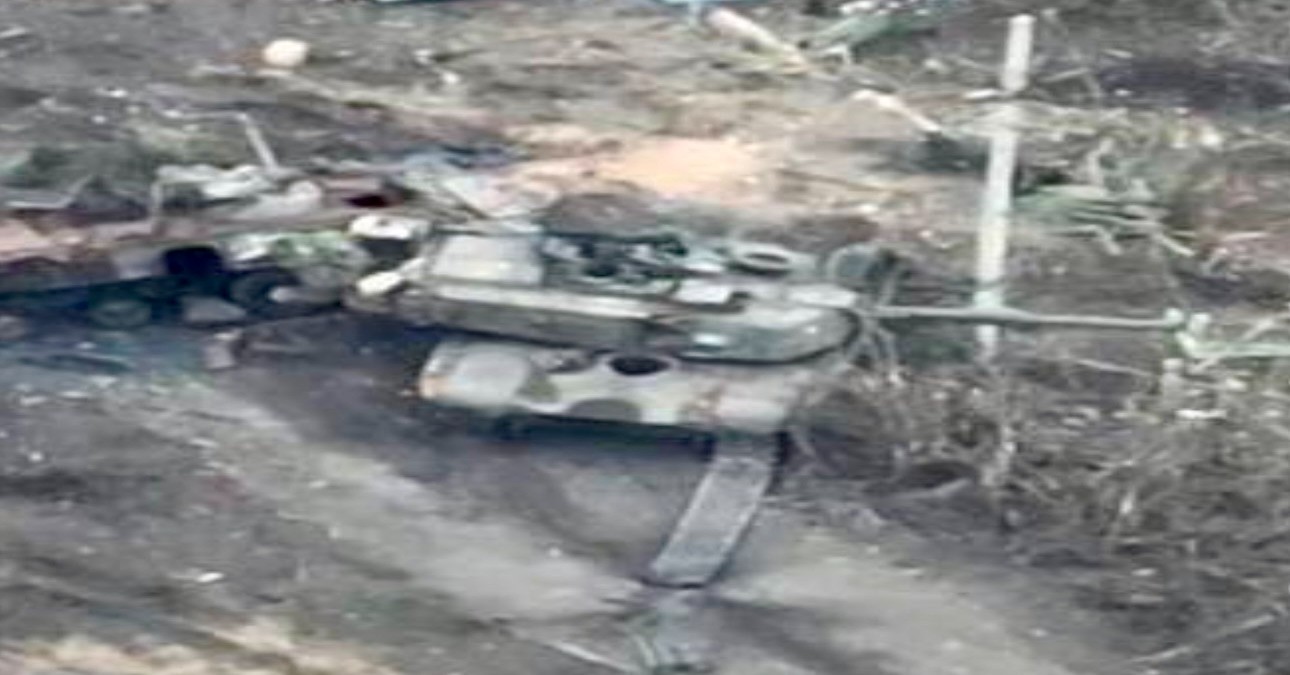Russian media has put out a video showing the destruction of an American Abrams tank, which was outfitted with Abrams Reactive Armor Tile-1 (ARAT-1) explosive reactive armor, by FPV (First Person View) drones.
The destruction of the Abrams tank shown in the footage purportedly occurred near Avdiivka several weeks ago. The video, according to the Russian Defense Ministry source speaking to Ria Novosti, showcases the moment when the American tank, equipped with the ARAT-1 armor mounted on its hull aprons, succumbed to the attack.
Although the tank’s tracks and rollers were purportedly protected, the FPV drones were still able to destroy the US-made tank.
“This is one of the tanks knocked out by the Center group of troops near Avdiivka. This particular one was destroyed a few weeks ago. You can see in slow motion the American ARAT-1 explosive reactive armor, it is mounted on the aprons of the Abrams hull,” the report claimed.
“Despite this protection of the tracks and rollers, our drone operators stopped the American tank. And the second drone finished him off. In slow motion, you can even see the crew standing nearby in bewilderment,” the source added.
🇷🇺 Tenkovi "abrams" opremljeni aktivnim oklopom ARAT-1 snimljeni u Ukrajini
Pretpostavka je bila da bi jedinice mogle dodatno da zaštite šasiju tenka, ali sudeći po snimku, zaštita nije pomogla.#rusija #ukrajina #abrams #tenk #oruzje pic.twitter.com/T0AI7owFJR
— RT Balkan (@rtbalkan) April 5, 2024
It is reported that the M1A1 Abrams and BMP Bradley tanks originally supplied to Ukraine lacked dynamic protection. However, footage emerged earlier in 2024, showcasing the installation of ARAT blocks on the tank’s body aprons, presumably to bolster its defensive capabilities.
Despite the protection for the Abrams’ undercarriage, the video footage indicated that the ARAT-1 armor was ineffective in preventing the tank’s destruction in this particular instance.
The Ministry of Defense of the Russian Federation has so far announced the destruction of six Abrams tanks during the ongoing conflict with Ukraine.
The ARAT (Abrams Reactive Armor Tiles) is a specialized reactive armor system developed specifically for the M1A1 and M1A2 Abrams combat vehicles following the 2004 Iraq War.
Derived from the Bradley Reactive Armor Tiles (BRAT) explosive reactive armor units designed for Bradley infantry fighting vehicles, the ARAT serves to mitigate damage to the vehicle it safeguards.
Explosive Reactive Armor (ERA) operates by employing a high explosive sheet or slab positioned between two metal plates, known as reactive or dynamic elements, to create an explosive reactive armor element.
Upon being struck by a penetrating weapon, the explosive within the armor detonates, separating the metal plates forcibly to disrupt the penetrator. This system is particularly effective as a defense against shaped charges and kinetic energy penetrators.
The ARAT provides additional layers of protection to both the tank and its crew members. Positioned on both sides of the hull and turret, these reactive tiles are designed to thwart penetration from various weapon systems, including RPGs (rocket-propelled grenades).
Western Tanks Found Wanting In Ukraine
During the initial stages of the conflict, when Russia experienced significant losses of its tanks, Western experts were quick to assert that Russian tank technology lagged behind its Western counterparts, citing a range of issues that rendered them unsuitable for modern warfare.
Following this, Western officials and experts began advocating that the introduction of Western tanks to Ukraine’s arsenal would result in a major shift on the battlefield.
Contrary to expectations, tanks including the Germany-supplied Leopard, the British 71-ton Challenger 2, and the US-made Abrams tanks have failed to yield substantial changes in the conflict’s dynamics.
In March, in an interview with Radio 1, Retired Russian colonel Viktor Baranets asserted that Russian forces have successfully neutralized a variety of Western tanks, including Leopards, British Challengers, American Bradley armored personnel carriers, and French M-10 tanks.
Baranets added that there was no Western tank that Russian forces could not disable and also said that they had acquired a comprehensive collection of knocked-out tanks from various Western manufacturers.
Baranets went on to critique the perceived superiority of Western tank technology, particularly singling out the Abrams tank. He argued that the tactical and technological attributes of the Abrams were often overstated and that these tanks were just as susceptible to destruction on the battlefield as any other.

“Russian anti-tank gunners, artillerymen, and drone operators managed to do everything necessary to destroy this tank,” he noted.
The Russian military expert further contended that Western military technology suffered from inherent weaknesses, attributing this to exaggerated claims perpetuated by the United States through misleading advertising.
He even proposed a symbolic gesture of displaying all Ukrainian tanks destroyed by Russian forces near the embassies of the countries that supplied them as a testament to their vulnerability on the battlefield.
- Contact the author at ashishmichel(at)gmail.com
- Follow EurAsian Times on Google News




